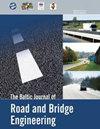Non-destructive modulus testing and performance evaluation for asphalt pavement reflective cracking mitigation treatments
IF 1.1
4区 工程技术
Q4 ENGINEERING, CIVIL
引用次数: 7
Abstract
Reflective cracking is a common type of pavement distress, which manifests as cracks in an underlying layer propagating through to the surface of a pavement structure. To minimize reflective cracking of asphalt layers in composite pavements, four treatments are commonly used: standard/full rubblization, modified rubblization, crack and seat, and rock interlayer. The four types of treatment were evaluated to determine their effectiveness in mitigating reflective cracking via non-destructive Falling Weight Deflectometer tests and Surface Wave Method tests to measure layer modulus, along with field pavement performance surveys. It is found that moduli measurements from Surface Wave Method tests have reduced uncertainty comparing to those from Falling Weight Deflectometer tests, (2) the moduli of thin rock interlayers were captured by Surface Wave Method, but missed by Falling Weight Deflectometer. In addition, the Surface Wave Method results show that (1) crack and seat treatments provide the highest moduli, followed by modified rubblization, and (2) standard rubblization and rock interlayers provide moduli that are slightly lower than the other two treatments. Pavement performance survey was also conducted concurrently with the in-situ modulus tests. Based on the results of this study, modified rubblization and rock interlayer treatments are recommended for mitigation of reflective cracking.沥青路面反射裂缝治理的无损模量试验及性能评价
反射裂缝是一种常见的路面病害,表现为下层的裂缝延伸到路面结构的表面。为了最大限度地减少复合路面沥青层的反射裂缝,通常采用四种处理方法:标准/全块石、改性块石、裂缝和底座以及岩石夹层。对这四种类型的处理进行了评估,以通过无损落锤挠度计测试和表面波法测试来测量层模量,以及现场路面性能调查来确定它们在减轻反射裂缝方面的有效性。研究发现,与落锤式挠度计测试相比,表面波法测试的模量测量降低了不确定度。此外,表面波法的结果表明:(1)裂缝和底座处理提供了最高的模量,其次是改性块石,(2)标准块石和岩石夹层提供的模量略低于其他两种处理。路面性能调查也与现场模量测试同时进行。根据这项研究的结果,建议采用改良碎石和岩石夹层处理来缓解反射裂缝。
本文章由计算机程序翻译,如有差异,请以英文原文为准。
求助全文
约1分钟内获得全文
求助全文
来源期刊
CiteScore
2.10
自引率
9.10%
发文量
25
审稿时长
>12 weeks
期刊介绍:
THE JOURNAL IS DESIGNED FOR PUBLISHING PAPERS CONCERNING THE FOLLOWING AREAS OF RESEARCH:
road and bridge research and design,
road construction materials and technologies,
bridge construction materials and technologies,
road and bridge repair,
road and bridge maintenance,
traffic safety,
road and bridge information technologies,
environmental issues,
road climatology,
low-volume roads,
normative documentation,
quality management and assurance,
road infrastructure and its assessment,
asset management,
road and bridge construction financing,
specialist pre-service and in-service training;

 求助内容:
求助内容: 应助结果提醒方式:
应助结果提醒方式:


